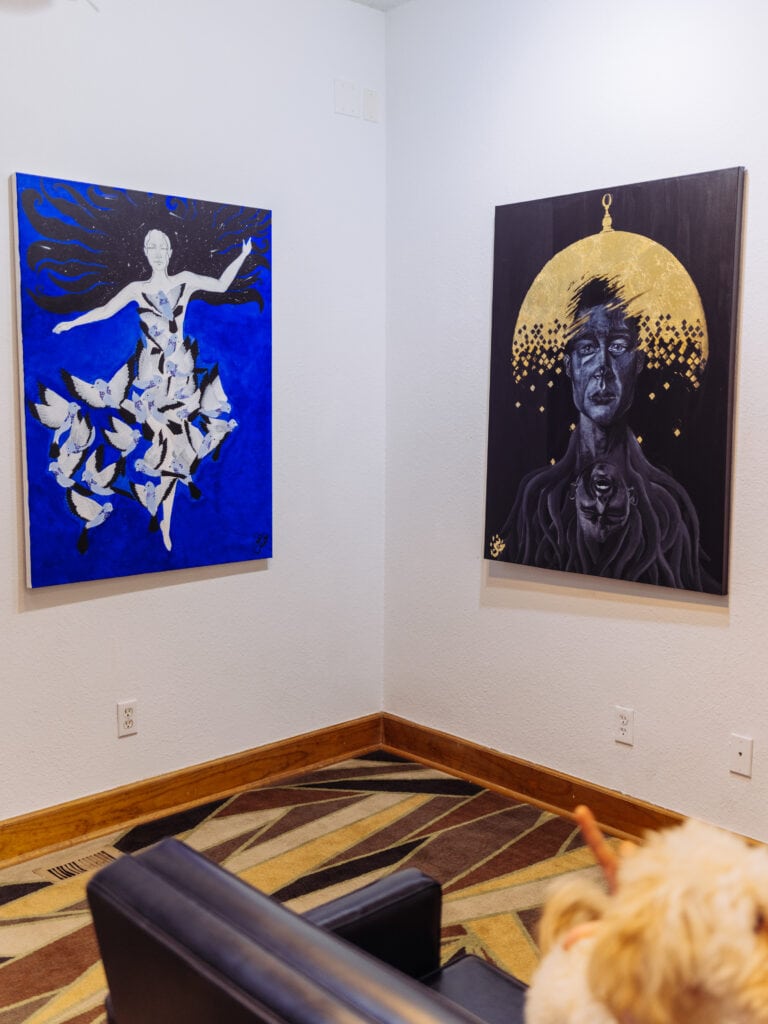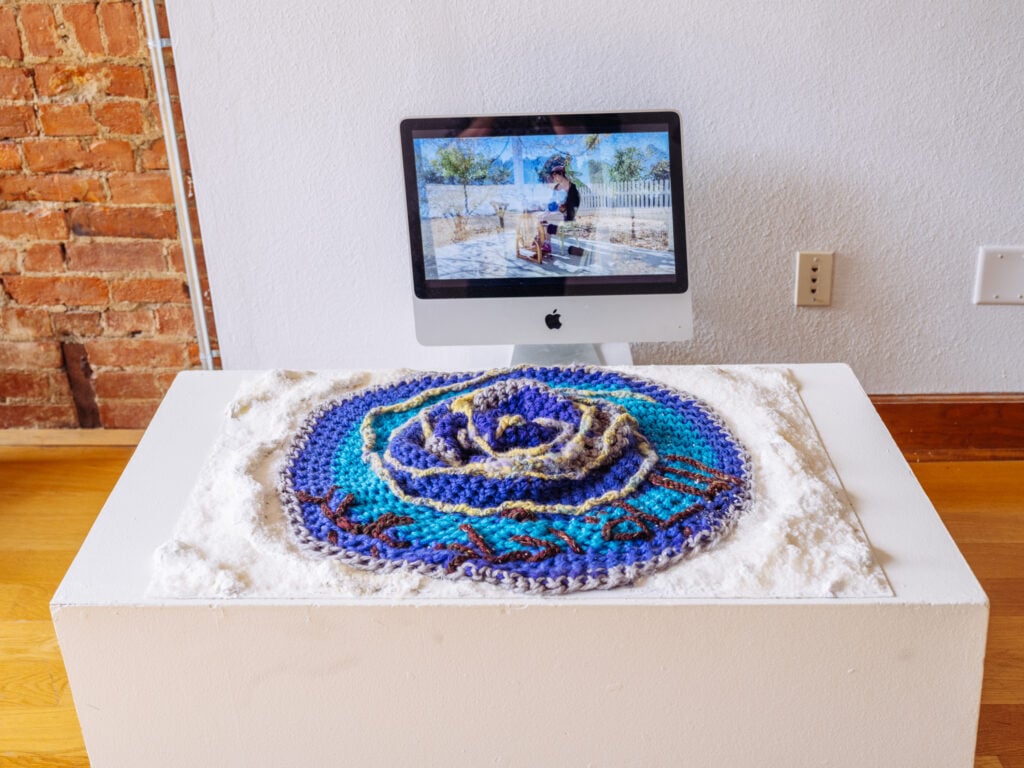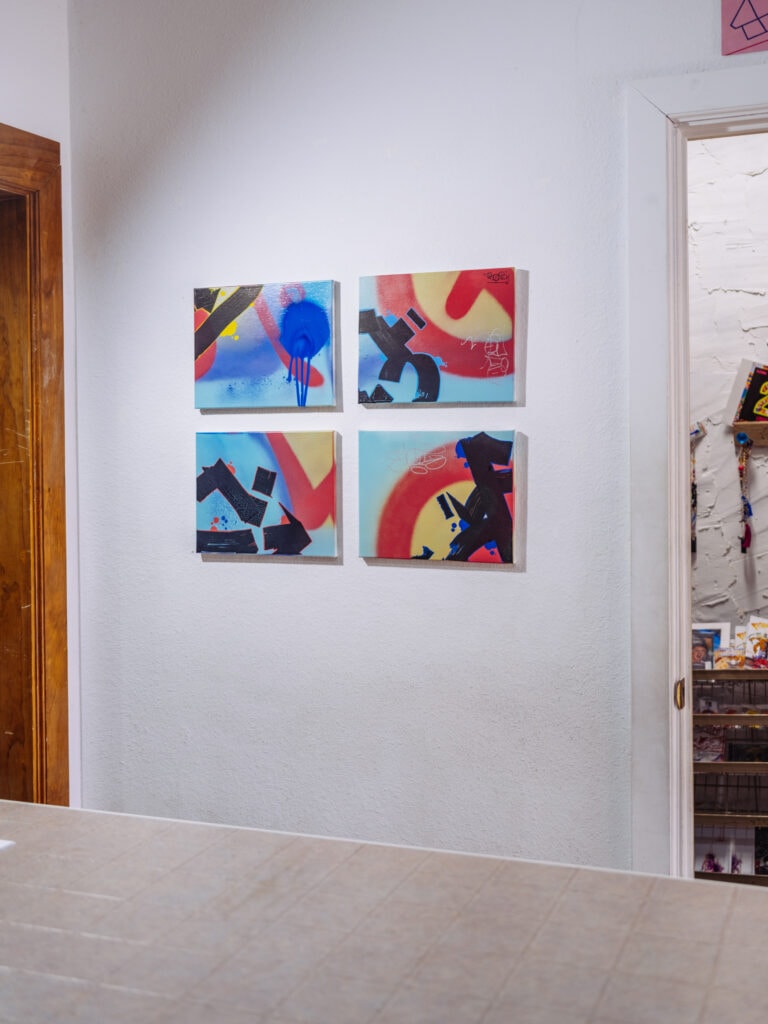Since only around 6% of Cincinnatians are foreign born, few Cincinnatians have experienced what it’s like to emigrate from one’s homeland to another country. Rumor has it that 70% of Cincinnatians have lived here all their life, so few locals know the challenges of making new friends, adopting new customs/sports teams, or negotiating regional dialects. “Transfer-Moving,” curated by Layan B. and Noel Maghathe, suggests that what people miss most about their homeland is food. A cursory glance around the gallery hit upon a plate piled high with dolma, people seated around tables, oranges, pomegranates, flower petals, recipe books, tea pots, and ceramic plates. When people visit their homeland, they often leave with foods unavailable in their new communities. I often return to Belgium with bottles of chipotle salsa packed in my bag.
Those who enjoy wine know the significance of terroir, such that local soil, rain, humidity, altitude, and sunlight combine efforts to nourish grape varietals. In boosting agriculture, terroir also informs local people’s identities. For those familiar with Shireen Nishat’s videos portraying women covered head-to-toe in black chadors and veils, Nadine Altounji’s Bint el Balad (2021), which translates as Daughters of the Land, seems worlds away in space and time. This ebullient video transports viewers to a joyful event where unveiled women sing their praises for their desert homeland. One repeated lyric is “Don’t give up. Keep moving,” which seems the perfect advice for this exhibition’s artists. One imagines Dalia Tuffaha’s digital prints serving as patterns for embroideries of local wildlife, including gazelles, hares, and hyena. Wildlife is no less terroir bound, which is why habitat modification invites extinction.

Mona Gazala’s corner installation In Defiance of Gravity (2023) featured a bone x-ray, a pomegranate totem balancing on a table, an image juxtaposing brains and pomegranates mounted on a light box, and a video.

Apparently, the ancient Egyptians were buried with pomegranates, which symbolize immortality. Archaeologists also found mummies accompanied by wood carvings of pomegranates. Pomegranates not only retard dementia, but their myriad seeds symbolize abundance, so it’s hardly surprising that the Qur’an identifies it as one of the fruits found in paradise. Rummani (2023), Amena Sheikh’s photograph of two hands clasping a broken-open pomegranate is overlaid with red and yellow cross stitches. Its title suggests yet another pomegranate seed reference.

Christina Hajjar’s video Don’t Forget the Water (2021) captures a woman receiving instructions over the telephone from her mother regarding how to boil a flavorful cup of Arabic coffee, overlayed by phrases such as “Don’t forget to breathe,” “Don’t forget to name it,” or “Don’t forget the label.” By contrast, Saif Alsaegh’s video 1991 (2018) depicts him chatting with his mother, an Iraqi refugee living in Turkey, as she describes the days leading up to his birth, which coincided with the first days of the US-Iraq War, while he cooks a pot of okra and tomatoes per her instructions.
Haneen Awad’s paintings A Peaceful Knight (2023) and Holy (2023) and are both buoyant, though the latter would appear otherwise were it hung upside down.

Of special note is AB Bedran’s installation Wrap Me in the Sea (2023), whose video features a woman spinning yarn, accompanied by a text. The screen is positioned above what appears to be a Category 5 hurricane (storm) fashioned out of yarn.

AA’s four paintings Flow (2022) resemble street art motifs, while Darwish (2023) pays tribute to the famous writer Mahmoud Darwish, who penned poems in Arabic.

Given its presentation of naked corpses hidden amidst forest trees, Nadine Hajjaj’s Requisite Corpse (2023) recalls Pablo Picasso’s Guernica (1937). Layla Zubi’s cracked plates decorated with blue house-like pentagons, entitled Dabke Watch (2021) and I Always Feel Like Somebody’s Watching Me (Dabke) (2021), convey eating, home, and dancing, since the Dabke is a popular line dance typically performed at Middle Eastern weddings.

Credit: Feda Eid
Nadia Msalek actually used green tea to paint both To Make Moroccan Tea (2022), a portrait of two women displaying a teapot as though they’ve won a trophy, and Vodnik’s Jars (2021), five colorful paintings of shapely teapots. In the context of this exhibition, Nic Hampton’s colorful embroidered felt books Kain Tayo (Let’s Eat!) (2022) and Kain Tayo! Again (Let’s Eat Again) (2023) evoke recipe books or diet journals.
